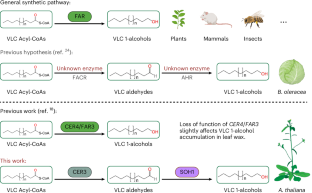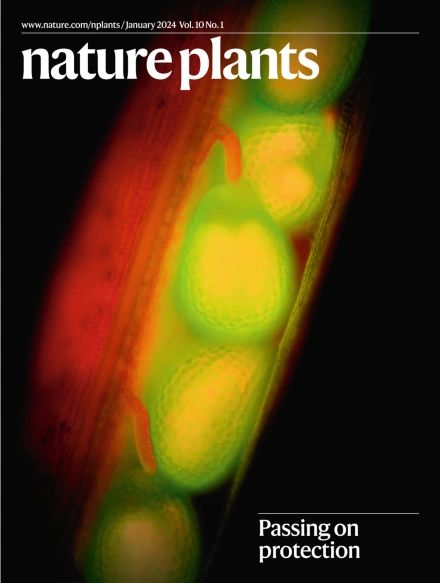拟南芥表皮蜡质生物合成核心分流机制及其在植物环境适应中的作用
IF 15.8
1区 生物学
Q1 PLANT SCIENCES
引用次数: 0
摘要
植物表皮蜡质对不同的环境具有高度的适应性1,2,3,4,5,6,7。脂肪族蜡由由1-醇或烷烃形成途径产生的超长链(VLC)化合物5,8组成。1-醇和烷烃在拟南芥中存在的差异表明,1-醇的含量与干旱因子呈负相关,而烷烃的含量则相反。碳资源如何在响应环境刺激的1-醇和烷烃途径之间分配仍然很大程度上是未知的。在拟南芥中,我们报道了一种新的1-醇生物合成途径,其中VLC酰基辅酶a首先被CER3还原为醛,然后通过新发现的假定醛还原酶SOH1转化为1-醇。CER3在烷烃合成过程中与CER1相互作用,现在也被鉴定为与SOH1相互作用,引导蜡质前体进入醇或烷烃形成途径,这些前体的定向转移受到SOH1 - CER3 - CER1模块的严格调控,以响应环境条件。本文章由计算机程序翻译,如有差异,请以英文原文为准。


Deciphering the core shunt mechanism in Arabidopsis cuticular wax biosynthesis and its role in plant environmental adaptation
Plant cuticular waxes serve as highly responsive adaptations to variable environments1–7. Aliphatic waxes consist of very-long-chain (VLC) compounds produced from 1-alcohol- or alkane-forming pathways5,8. The existing variation in 1-alcohols and alkanes across Arabidopsis accessions revealed that 1-alcohol amounts are negatively correlated with aridity factors, whereas alkanes display the opposite behaviour. How carbon resources are allocated between the 1-alcohol and alkane pathways responding to environmental stimuli is still largely unknown. Here, in Arabidopsis, we report a novel 1-alcohol biosynthesis pathway in which VLC acyl-CoAs are first reduced to aldehydes by CER3 and then converted into 1-alcohols via a newly identified putative aldehyde reductase SOH1. CER3, previously shown to interact with CER1 in alkane synthesis, is identified to interact with SOH1 as well, channelling wax precursors into either alcohol- or alkane-forming pathways, and the directional shunting of these precursors is tightly regulated by the SOH1–CER3–CER1 module in response to environmental conditions. The study uncovered a novel wax alcohol-forming pathway involving a two-step reduction process and further elucidated the carbon relocation mechanism between the alcohol- and alkane-forming pathway in response to environmental cues.
求助全文
通过发布文献求助,成功后即可免费获取论文全文。
去求助
来源期刊

Nature Plants
PLANT SCIENCES-
CiteScore
25.30
自引率
2.20%
发文量
196
期刊介绍:
Nature Plants is an online-only, monthly journal publishing the best research on plants — from their evolution, development, metabolism and environmental interactions to their societal significance.
 求助内容:
求助内容: 应助结果提醒方式:
应助结果提醒方式:


